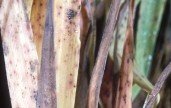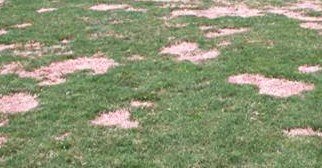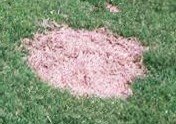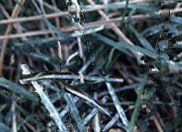Cool Weather Lawn Diseases
of Spring and Fall
Cool Weather Lawn diseases can be very troubling and even the best lawns can be affected. Many diseases begin in the cool weather of spring and fall and knowledge is the key to preventing disease. This page gives specific information on cool weather lawn diseases, how and when they start, and how to treat them.
Introduction to
Cool Weather Lawn Diseases
Cool Weather lawn diseases are common with virtually all grass types. Although they are naturally occurring, how damaging they are can depend greatly on how we manage our lawns.
We know that lawns must be carefully maintained. However, if done improperly, we can actually predispose our grass to diseases. Proper cultural practices that hinder disease development is your first line of defense against lawn diseases.
Microscopic living organisms are the cause of lawn diseases. They are primarily pathogenic fungi, but also include bacteria, nematodes, phytoplasmas, and a few other organisms.
Since most are caused by pathogenic fungi, we will focus mostly on those. The fungi can remain dormant in the soil until environmental conditions favor an outbreak. Lawn Diseases can also be distributed by wind, splashing rain, foot traffic, equipment, etc. Since these fungi lack roots, stems, or chlorophyll, they get their nutrients from their host.
When numbers reach a threshold or a tipping point, if environmental conditions are right and have a susceptible grass species, then something like too heavily applied nitrogen fertilizer can trigger an outbreak in just hours. In days, an entire yard can be affected.
Pathogenic fungi penetrate the host plant when conditions favor the disease. An important note in diagnosing diseases is that an infected plant will display specific symptoms and visible damage that is characteristic of that particular pathogen.
Three conditions must be met before lawn diseases can begin.
- There must be a pathogen present in and around your soil.
- Your grass type must be susceptible to that specific pathogen.
- The environmental conditions must be right for the disease to develop.
- **These conditions must be met for Cool weather lawn diseases as well as warm weather diseases to begin.
The most important of these is the environmental conditions. It is an almost certainty that pathogens are constantly present in your soil. However, it is a necessity for the environmental conditions to be correct before anything will happen.
Your best defense against lawn diseases is to overseed or plant resistant grass and to perform cultural practices that discourage them. Read the section on Maintaining your lawn to Discourage Disease Below are specific disease profiles of common cool weather diseases.
Helminthosporium Leaf Spot and Melting Out Disease
Disease Overview
Leaf spot is a cool weather lawn disease that appears during cool, drizzly, moist spring weather. Heavy, wet dews, high humidity on overcast days, watering at night, and frequent rain will encourage disease growth.
The disease over-winters in thatch, soil, or in lesions of infected grass. Just as soon as environmental conditions are right, the disease will appear.
In cool season grasses, helminthosporium leaf spot is a problem for all grasses. Tall fescue, Kentucky bluegrass, and ryegrass are most affected.
In warm season grasses, bermudagrass is most affected, although all warm season grasses are able to get the disease. Different species of the fungus will attack different types of grasses.
Disease Symptoms
The disease has two stages. The first stage is the “leaf spot” stage. Small, purple spots appear on the grass blade. The spots vary in size depending on the particular fungi from to 1/32 to 1/4 inch depending on the grass type affected.
As the spots expand, the center of the spot becomes tan, but the outside edges will remain purple. The larger spots can take on an hour glass appearance and eventually the whole grass blade appears tan with black spots throughout.
The second stage is the “melting out” stage. It occurs when the environmental conditions that favor the disease persist and the disease spreads to the grass crown. When that happens, the disease enters the melting out phase and the grass dies. The roots become stunted and black.
The leaf spot stage is less serious of the two. If while in the leaf spot stage, the environmental conditions change becoming drier, the disease will usually stop and the grass will grow out of it. If conditions remain the same, the grass will turn yellow to orange and die from the tip down.
Cultural Practices that Discourage Cool Weather Lawn Diseases
Do not over-fertilizer the grass. Be especially careful in early spring if you have had problems before. Succulent grass will only feed the disease making it worse.
For cool season grass, use slow release nitrogen in the spring while keeping the amount per 1000/sq.ft. on the lean side. A common mistake in spring is to over-fertilize. The goal is to only replace the amount of nutrients used in early spring surge growth. You will need to follow a balanced fertility program like what w4 provide on this site.
For warm season grass, do not fertilize before the grass breaks dormancy. It is best to wait until the temperatures warm significantly before the first application goes down. Do not fertilize in the fall since the disease can return in the cooler weather.
Wet Conditions and How It factors In
Moisture is very important to the onset of this cool weather lawn disease. This can occur either by prolonged rain or by improper irrigation.
Try not to irrigate unless the grass needs it. Also, do not irrigate in the evening or at night. Rather, water in the early morning when the dew is still on the grass. If you water after the dew has dried in late morning, it wets the soil and grass again extending the amount of time the grass and soil is wet.
Syringing The Grass
If you have experienced disease problems before, removing heavy dew is important before disease symptoms appear. Use the hose or sprinkler to wash off the dew. Just a quick blast of water will do it. It is a common practice called "syringing". This washes off the guttation fluid (sugar secreted onto the grass surface) that feed the fungus This sugar is a food source for leaf spot and many other pathogenic fungi.
Dragging a hose over the grass is also effective in removing dew but is not as effective as syringing. Golf courses have practiced this for many years.
Herbicide Use During Disease Activity
Avoid the over use of herbicides during disease activity. If you need to spray for weeds, spot spray only. Dicamba, 2,4-D and other herbicides have been known to encourage leaf spot and other lawn diseases.
Fungicide Use
Fungicides are not needed if the disease doesn’t progress past the leaf spot stage. Cool weather lawn diseases that affect only the blades can grow out. Not so much when it affects the roots and by then it may be too late.
If you believe that fungicides are warranted, they must be applied as soon as symptoms are observed. Once the disease reaches the crown, the grass affected will die.
Products such as Heritage, Compass, Disarm and Insignia are labeled for use on lawns. Be aware that fungicides containing “Chlorothalonil” is no longer labeled for lawn use at the time of this writing.
Read the product label carefully and completely before use. Fungicides can be difficult to apply correctly and safely. Timing of the application is important. If you are uncertain about how to apply it after reading the label, check with the county extension office for further help. You may want to hire a licensed professional with experience in lawn diseases to apply the chemical for you.
Spring Dead Spot
Disease Overview
Spring Dead Spot is one of the most damaging cool weather lawn disease of bermudagrass. There are a number of fungi that may cause the disease, but in the U.S. it is Leptosphaeria Korrae and Ophiospharella herpotricha.
The disease generally attacks mature bermudagrass lawns that have been established for over three years.
Healthy turfgrass better resist diseases than unhealthy grass. The most susceptible grasses are those that are stressed and weakened from growing in poor soil, has been poorly maintained, or when growing outside it climate zone.
How This Cool Weather Lawn Disease Operates
This cool weather lawn disease actually begins in the fall, but the evidence of the disease doesn’t appear until spring.
In the fall, when the soil cools to 80 degrees, the disease becomes active and infects the roots. The disease is not noticed because the grass will soon start to go dormant. When spring approaches, the disease progression speeds up. The roots are not able to take up nutrients or break dormancy and the grass quickly dies.
Disease Symptoms
The disease is noticed in spring as the grass is breaking dormancy and greening up. You will notice patches of grass that look sunken and have a dead, whitish look. It actually died during the winter. Dead, white grass is a different look from healthy dormant grass.
The patches of dead grass are circular ranging from 6 inches to 3 feet in diameter. They will often coalesce leaving larger, more irregular shaped patches. The patches are dead and cannot be saved.
Eventually the grass will spread into the damaged area, but it will continue to have problems.
Killing the grass and putting down new sod can eventually lead to the same problems without efforts to stop it since the microbes live in the soil.
Cultural Practices that Discourage Disease Development
If you have had problems with the disease before, it is important to maintain potash (K) levels in the soil. (K) or Potash is also referred to a Potassium, represented by the third number on a fertilizer bag. Even small deficiencies in K lowers the grass’ resistance to the disease. Potassium is a stress reducer and helps grass through difficult times.
Even if a soil test shows the level to be adequate, you still need to apply 1 lb of potash per 1000/sq.ft. to soil. However, not more than a pound per 1000/sq.ft. should be applied at one time. You can purchase fertilizer that contains only Potassium. It will look something like 0-0-15. The last number will depend on the percentage of K in the bag.
Maintain the soil pH at 5 to 5.5. No one knows exactly why this helps, but it does. Either the grass’ resistance is raised or microorganisms that are antagonistic to spring dead spots are more active at that pH range.
Raise the mower blade. Higher mowing heights means deeper roots and more blade for carbohydrate production. It may provide enough resistance if disease pressure is low.
Keep thatch to acceptable levels of ½ inch. Use a dethatching machine if you have severe thatch problems. Annual core aeration works well to keep thatch levels within a desirable range.
Ammonium Sulfate Nitrogen Source
This is one of the times when applications of Ammonium Sulfate fertilizers to help speed recovery of damaged areas. Make sure you water the fertilizer in directly after application to avoid burning the grass.
Studies have shown that the grass responds better with a
Ammonium Sulfate than when using urea based nitrogen. In addition, the Ammonical fertilizers do not remain in the root zone for as long as coated urea products. This is important because you want the nitrogen to be used up when fall approaches and the disease becomes active again.
Do not use fertilizer containing Ammonium Nitrate, however. Ammonium Nitrate is not the same thing as Ammonium Sulfate and will will not give you the desired results.
Fungicide Use
Several fungicides are labeled for spring dead spot. However, university tests have shown that fungicides are not always successful in controlling this disease. Some products displayed no noticeable results at all. For others, results were inconsistent at best. If you do use a fungicide, it must be applied in September or when temperatures dip below 80 degrees. It must be applied as the disease activity begins.
If you are using Turf Formula all year the disease may not be present in numbers that can start in infection. Be sure to look at the product and save yourself a lot of headaches.
Red Thread and Pink Patch Diseases
Disease Overview
Red thread and pink patch are cool season lawn diseases that often occur together. A variety of grass types are affected including Kentucky bluegrass, fine fescue, ryegrass and bentgrass. The fine fescues and ryegrass may be the most severely affected.
This cool season lawn disease is one of the easiest to identify. The late stages of red thread lawn disease produces a network of bright pink to reddish color fungus with a thread-like appearance. On cool, damp mornings, the lawn fungus covers the grass with a pink, gelatin like mycelium. Pink patch develops a gelatinous, pink fungus on the grass. They are easy to spot.
The lawn disease attacks grass that is low in nitrogen. Their development favors cool, wet spring and fall weather. you will often see them during extended periods of damp, drizzly, overcast conditions. This disease has also been known to appear as snow is melting in winter. Mild winters will generally see more occurrences of the disease than harsh winters.
Disease Cycle The disease over-winters in in thatch and organic lawn debris. The following spring as temperatures reach 65 degrees the disease becomes active. Moisture is important for the disease to spread. Prolonged dampness from rain, dew, or irrigating in the evening or at night accelerates the disease activity.
Once the disease starts, it can be easily spread by mowing. Collecting the grass clippings and disposing of them may slow the disease spread. Animals or people walking across the lawn can pick up and deposit the lawn fungus in other areas.
Cultural Practices that Discourage Disease Growth
Be sure to maintain proper nitrogen levels in the turf. The disease doesn’t usually attack healthy grass. Lawns that are low in nitrogen will be the most severely affected.
Don’t over-fertilize thinking this will work to prevent this disease. You will predispose your grass to other lawn diseases, such as leaf spot.
Fungicide Use
Red thread usually isn’t a serious lawn disease and fungicide use isn’t recommended. If you properly maintain your lawn with sufficient nitrogen recommended for your grass type you will have few problems.
Click on the Fertilization Page for help in developing a fertility program.
Powdery Mildew Cool Season Lawn Disease
Disease Overview
Powdery mildew isn’t usually a serious lawn disease. It looks a little worse than it actually is. The grass will look as if someone dusted it with a white powder. If you touch the blade, the powder will easily brush off.
It is primarily a lawn disease that grows in light to heavy shade. The most commonly affected is Kentucky Bluegrass, but fescue can also get the disease. The disease occurs when temperatures average 60 to 70 degrees during the cool, humid weather in spring or fall.
Powdery mildew lawn fungus will not invade the crown or roots, but remains on the blade surface. However, the fungus produces structures that will pierce the grass’ outer leaf layer to draw nutrients. It does not attack as aggressively as other diseases.
The biggest problem may be that the heavy coating of white powdery mycelium blocks the sunlight and prevents photosynthesis from taking place. If the powder remains, the leaves will turn yellow and could die back. Getting out the mower and bagger will help remove the grass covered blades.
Conditions that Promote The Disease
This lawn disease grows in the shade during cool, humid spring weather. It doesn’t need heavy dew conditions to germinate like other lawn diseases. It is most severe under shade trees or on the shady side of homes. Trees with a dense canopy and low hanging branches are prime candidates for powdery mildew due to reduced air circulation. The low hanging branches trap air and humidity, thus providing the right environment for disease activity.
While the lawn disease is active, fertilization and excessive water may help accelerate the disease. The spores are spread to uninfected grass while mowing or from the splashing of water from rain or sprinklers. When mowing, bag the grass to prevent it from spreading faster.
Common varieties of Kentucky bluegrass are not considered to be shade tolerant. As the leaves fill the trees in spring, the grass weakens. In this weakened condition, the grass offers little resistance to disease growth.
Disease management
Prune low hanging limbs as well as limbs in the canopy to allow in more light and better air circulation. On shady sides of homes, over-seed the area with shade tolerant and powdery mildew resistant varieties. Shade tolerant varieties of Kentucky bluegrass include America, Bensun, Exlipse, and Glade. With these grasses you get two things in one: shade tolerance and disease resistance.
Fungicide Use
Use fungicides as a last alternative. Some fungicides can be expensive, so you will have to compare the cost with the unsightliness of the disease.
Contact fungicides are protective (preventative) and need to be applied before the lawn disease begins for best results. Fungicides applied after the disease has begun may have little or no effect. Examples of fungicides for powdery mildew are Clearys 3336F or Fungo Flo 4.5F Carefully follow all directions on the label. Other fungicides are also available.
Hot Weather Lawn Diseases
The dog days of summer can also being some of the most damaging disease. Click here for common summer lawn disease profiles, including how they start, recognizing disease symptoms as well as treatment options.
Cultural Practices that Discourage Diseases
Are your maintenance practices weakening your grass? Stressed and weakened grass is more susceptible to disease. Using proven methods to care for your lawn is far more beneficial than you think.
Understanding Lawn Fungicides
Never used a fungicide? While cultural practices are the best way to prevent diseases, you may someday find it necessary to use a fungicide. Knowing what they are and how they work is important for successful disease control.
Using Herbicides Safely
Your safety, the safety of your family and the environment should be your greatest concerns when using lawn chemicals. This page is loaded with valuable information about personal protective equipment, mixing, using and storing lawn chemicals.
Cool Weather Diseases back to Grass Diseases Introduction
Cool Weather Diseases back to Lawn Care Academy Home
Share This page:
How Turf Formula Can Stop Many Diseases
Turf Formula Prebiotic and Soil Nutrient Booster increases naturally occurring beneficial soil microorganisms by 3400% in 24 hours and by 5000% in 72 hours. Many of these microbes feed upon pathogenic microbes. It can stop some diseases before they start. Check out our page on Turf Formula to see what it can do.
Click Here to Check Out Our Turf Formula







